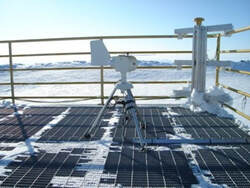Atmospheric Pollen TransporT
How can we use this as a tracer for air masses?
Because tree pollen can travel over long distances, it can be used as a tracer for atmospheric circulation. Pollen samples from the high Arctic and from Sable Islands (offshore Nova Scotia), two locations where there are no trees, are analyzed and atmospheric models are used to determine the source of the pollen.
This knowledge will be applied to study past changes in atmospheric circulation. And I will then put the variability of sea surface conditions during the Holocene in relation with changes in atmospheric circulation.
Loss of sea ice in the Arctic will no doubt affect the way air masses circulate. And winds also exert a certain control on oceanic currents. And to close the loop, oceanic currents affect the climate. With a better understanding of the links between ocean and atmosphere, we will be better prepared to anticipate the impacts of climate change!
This is an ongoing project and students interested in graduate studies are welcome to contact me.
This knowledge will be applied to study past changes in atmospheric circulation. And I will then put the variability of sea surface conditions during the Holocene in relation with changes in atmospheric circulation.
Loss of sea ice in the Arctic will no doubt affect the way air masses circulate. And winds also exert a certain control on oceanic currents. And to close the loop, oceanic currents affect the climate. With a better understanding of the links between ocean and atmosphere, we will be better prepared to anticipate the impacts of climate change!
This is an ongoing project and students interested in graduate studies are welcome to contact me.

Pollen sampler at Eureka, 80°N